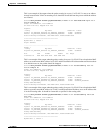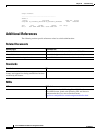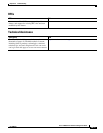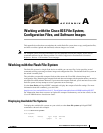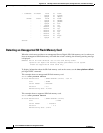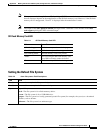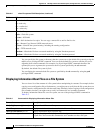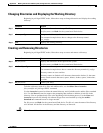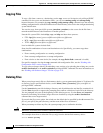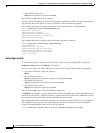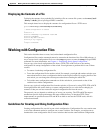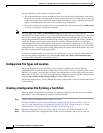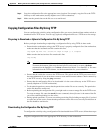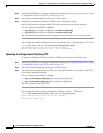
A-5
Cisco IE 2000 Switch Software Configuration Guide
OL-25866-01
Appendix A Working with the Cisco IOS File System, Configuration Files, and Software Images
Working with the Flash File System
Changing Directories and Displaying the Working Directory
Beginning in privileged EXEC mode, follow these steps to change directories and display the working
directory:
Creating and Removing Directories
Beginning in privileged EXEC mode, follow these steps to create and remove a directory:
To delete a directory with all its files and subdirectories, use the delete /force /recursive
filesystem:/file-url privileged EXEC command.
Use the /recursive keyword to delete the named directory and all subdirectories and the files contained
in it. Use the /force keyword to suppress the prompting that confirms a deletion of each file in the
directory. You are prompted only once at the beginning of this deletion process. Use the /force and
/recursive keywords for deleting old software images that were installed by using the archive
download-sw command but are no longer needed.
For filesystem, use flash: for the system board flash device. For file-url, enter the name of the directory
to be deleted. All the files in the directory and the directory are removed.
Caution When files and directories are deleted, their contents cannot be recovered.
Command Purpose
Step 1
dir filesystem: Displays the directories on the specified file system.
For filesystem:, use flash: for the system board flash device.
Step 2
cd new_configs Changes to the directory of interest.
The command example shows how to change to the directory named
new_configs.
Step 3
pwd Displays the working directory.
Command Purpose
Step 1
dir filesystem: Displays the directories on the specified file system.
For filesystem:, use flash: for the system board flash device.
Step 2
mkdir old_configs Creates a new directory.
The command example shows how to create the directory named old_configs.
Directory names are case sensitive.
Directory names are limited to 45 characters between the slashes (/); the name
cannot contain control characters, spaces, deletes, slashes, quotes, semicolons,
or colons.
Step 3
dir filesystem: Verifies your entry.



